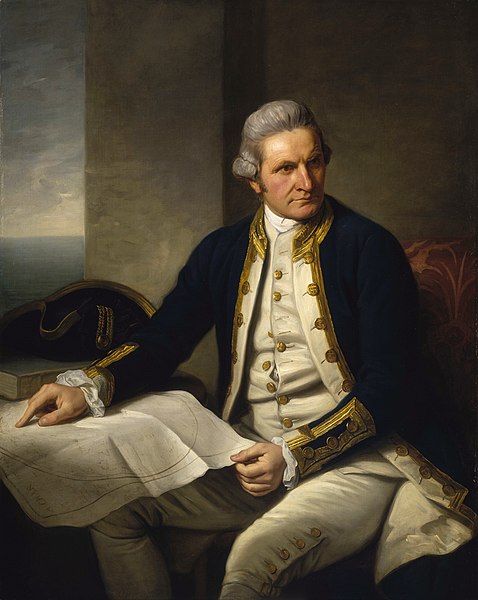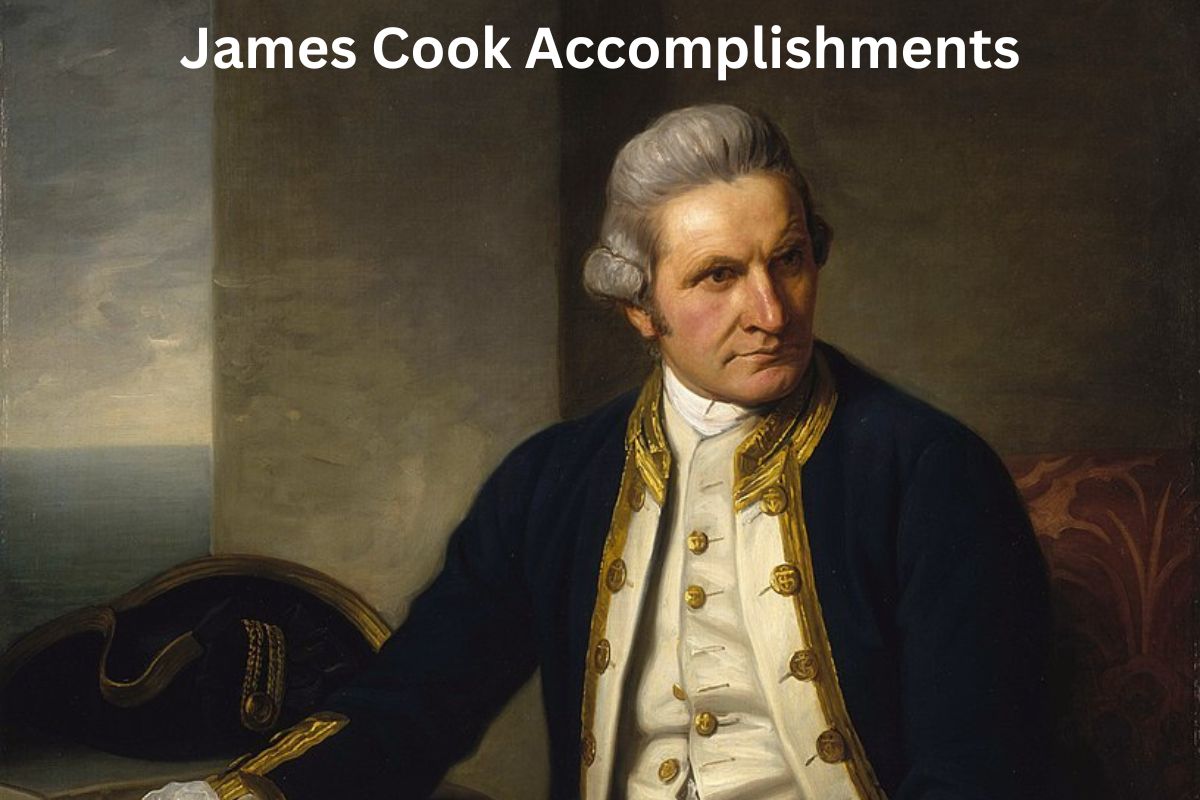James Cook was a renowned British explorer and navigator who lived from 1728 to 1779. He made significant contributions to geographical discovery and scientific exploration during the 18th century.
Cook is best known for his voyages that led to the mapping and exploration of the east coast of Australia, the discovery and mapping of New Zealand, and extensive exploration of the Pacific Ocean.
His meticulous documentation, accurate mapping, and scientific observations greatly expanded European knowledge of the Pacific region, including its islands, cultures, and natural phenomena.
Cook’s legacy extends beyond exploration, as he introduced preventative measures against scurvy and his voyages laid the foundation for advancements in navigation and scientific exploration. James Cook remains an influential figure in the history of exploration and a symbol of discovery and adventure.
Accomplishments of James Cook
1. Charting the east coast of Australia
James Cook’s first voyage, which took place from 1768 to 1771, was primarily focused on observing the transit of Venus across the sun. However, Cook was also tasked with exploring and charting the largely unknown eastern coastline of the continent we now know as Australia.
Also Read: Facts About James Cook
Cook and his crew meticulously surveyed the coast, producing detailed maps and charts of the region. His exploration led to the discovery and naming of many prominent landmarks, including Botany Bay, where the first European settlement in Australia was later established.
Cook’s thorough mapping of the east coast provided invaluable information for future explorers and ultimately paved the way for the British colonization of Australia.

2. Discovering and mapping New Zealand
During his first voyage, Cook became the first European to accurately map the entire coastline of New Zealand. His ship, the HMS Endeavour, arrived in New Zealand in October 1769, and Cook spent several months circumnavigating both the North and South Islands.
He meticulously surveyed and charted the coastline, producing highly accurate maps that improved European understanding of the islands’ geography. Cook’s encounters with the indigenous Māori people were recorded in his journals and provided important insights into their customs and way of life.
Cook’s exploration of New Zealand remains significant to this day, and his maps formed the foundation for subsequent European settlement and navigation in the region.
3. Exploring the Pacific Ocean and mapping numerous islands
James Cook’s voyages took him across vast stretches of the Pacific Ocean, during which he explored and mapped numerous islands and archipelagos. His first voyage, as mentioned earlier, involved sailing through the Pacific to reach New Zealand and Australia.
Cook’s second voyage, from 1772 to 1775, focused on further exploration of the Pacific. He discovered and charted the Society Islands (including Tahiti), the Marquesas Islands, Tonga, and the Cook Islands, among others. His meticulous mapping and descriptions of these islands greatly expanded European knowledge of the Pacific region.
Cook’s third voyage, from 1776 to 1780, aimed to locate a rumored southern continent, but he instead crossed the Antarctic Circle and made significant progress in mapping the Southern Ocean. His exploration of the Pacific Ocean opened up new horizons and contributed to a deeper understanding of the world’s geography.
4. Accurate measurement of longitude at sea
One of the most significant contributions of James Cook’s voyages was his work on accurately measuring longitude at sea. Determining longitude was a pressing problem for navigators at the time, as it was crucial for accurate navigation and avoiding hazards.
Cook employed the use of newly developed marine chronometers, particularly the timepiece created by John Harrison, known as the H4 chronometer. These chronometers provided a reliable means of measuring time at sea, enabling sailors to determine their longitude by comparing local time with the time at a known reference point.
Cook’s meticulous implementation of these chronometers and his emphasis on precise timekeeping greatly improved navigation accuracy and facilitated safer and more efficient long-distance voyages.
5. Crossing the Antarctic Circle three times
During his second voyage (1772-1775), James Cook ventured farther south than any previous explorer at the time. He crossed the Antarctic Circle three times, making significant progress in exploring the Southern Ocean and pushing the boundaries of Antarctic exploration.
Although Cook did not directly encounter the Antarctic continent itself, his voyages expanded knowledge of the icy conditions and introduced European explorers to the harsh environment of the southern polar region.
Cook’s courage and determination in exploring these extreme latitudes paved the way for future Antarctic expeditions and contributed to our understanding of the Earth’s geography.
6. Discovering the Great Barrier Reef
In 1770, during his first voyage, James Cook’s ship, the HMS Endeavour, ran aground on the Great Barrier Reef off the coast of present-day Queensland, Australia. This event led to the discovery of the world’s largest coral reef system, stretching over 2,300 kilometers (1,400 miles).
Despite the challenges and damage to the ship, Cook and his crew spent several weeks repairing the vessel while also taking the opportunity to study and document the unique marine life and ecosystems of the reef.
Cook’s observations and meticulous charts of the Great Barrier Reef significantly expanded European knowledge of coral reefs and their ecological importance.
Today, the Great Barrier Reef remains a UNESCO World Heritage site and stands as one of the world’s most extraordinary natural wonders, thanks in part to Cook’s accidental discovery.
7. Documenting Pacific cultures and peoples
Throughout his voyages, James Cook and his crew had extensive interactions with the indigenous peoples of the Pacific islands they encountered. Cook had a keen interest in understanding the social, cultural, and linguistic aspects of the Pacific cultures.
He and his crew made detailed observations, recorded their encounters, and documented various aspects of the local customs, traditions, and languages. Cook’s journals and the accounts of his crew provide invaluable ethnographic records of Pacific islanders during the 18th century.
These records have been of great historical and anthropological importance, offering insights into the diverse cultures and societies of the Pacific that might otherwise have been lost to history.
8. Voyage to the Antarctic and venturing farther south than any previous explorer
During his third and final voyage (1776-1780), James Cook set sail with the objective of locating a southern continent, often referred to as “Terra Australis.”
Although he did not discover the fabled continent, Cook made significant progress in exploring the Southern Ocean and became the first recorded person to cross the Antarctic Circle in the Southern Hemisphere. His ships penetrated further south than any previous expedition, reaching approximately 71°10’S latitude.
Cook’s voyage to the Antarctic, although focused on geographical exploration, also added to scientific knowledge about the extreme environment of the polar region and the challenges of navigating icy waters.
9. Introduction of preventative measures against scurvy
Scurvy, a disease caused by vitamin C deficiency, plagued sailors on long voyages during Cook’s era. Recognizing the importance of maintaining the health of his crew, Cook implemented strict measures to combat scurvy during his voyages.
He emphasized cleanliness, proper ventilation, and the provisioning of a balanced diet that included fresh foods rich in vitamin C, such as citrus fruits and sauerkraut. These measures significantly reduced the incidence of scurvy among Cook’s crew compared to other contemporary naval expeditions.
Cook’s emphasis on maintaining crew health and his success in preventing scurvy contributed to improved conditions and increased survival rates on long sea voyages, leading to advancements in naval and maritime exploration.
10. Legacy of scientific exploration and expanding knowledge in various fields
James Cook’s voyages had a lasting impact on scientific exploration and knowledge across various fields. Cook and his crew conducted extensive botanical studies, collecting and documenting numerous plant specimens from the Pacific islands they visited.
These botanical collections contributed to advancements in the study of plant taxonomy and provided a wealth of information about previously unknown species. Cook also made significant contributions to geology, mapping coastlines and recording geological formations.
Additionally, his observations of celestial bodies, such as the transit of Venus, and his meticulous navigation techniques improved the accuracy of astronomical and navigational calculations.
Cook’s commitment to scientific inquiry and his comprehensive documentation of natural phenomena paved the way for further scientific exploration and greatly expanded knowledge in the fields of botany, geology, astronomy, and ethnography. His legacy continues to inspire and inform scientific endeavors to this day.
